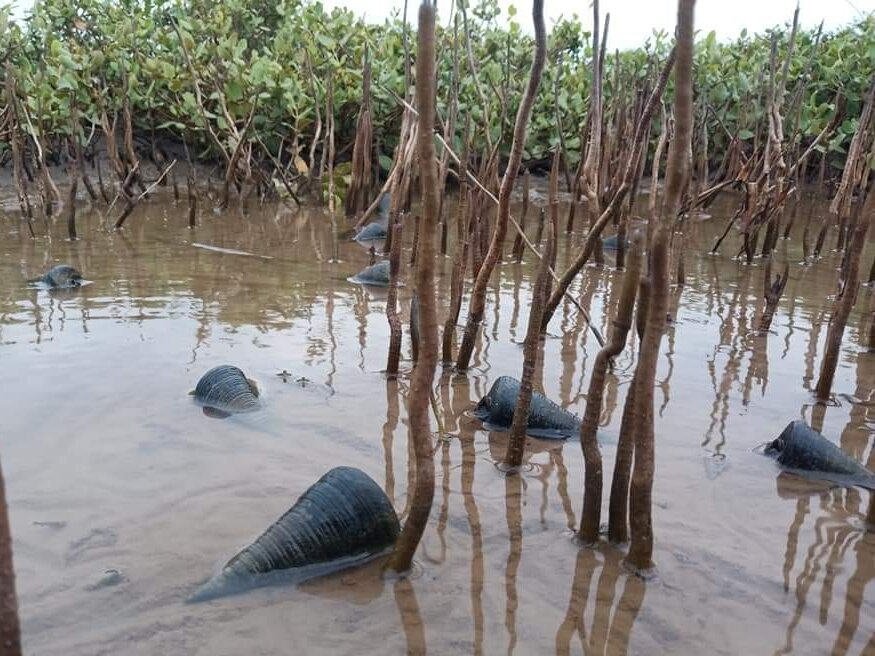Mangrove Snails (Telescopium telescopium): Pests Become Benefits

Photo Credit : Mayur Fulmali
In the cultivation of ponds in mangrove lava, especially in shrimp ponds, mangrove snails are considered annoying pests and usually these snails are collected or weakened with poison. Snails with the Latin name Telescopium telescopium is a gastropod that is included in the Family Potamididae and Ordo Megagastropoda.
- Morphology and Habitat
The morphology of this animal can be recognized by its cone-shaped, long, slender and slightly horizontal shell at the base. The color of the shell is turbid brown, purplish brown and blackish-brown, on the outer layer of the shell is equipped with very tight spiral stripes and has inwardly curved stripes. The length of the shell ranges from 4.5-11 cm. The length of shells found in mangrove forest areas is longer than that found in ponds. The difference in size found in each habitat is due to the availability of feed in mangrove forest areas better than in fish ponds, also due to environmental factors (Ardani, 1997). Reproduce with dioecious properties (separate between male and female), while fertilization occurs in the body.
The habitat of this animal is in swampy environments, swamps, and flooded freshwater areas along coasts and rivers. They are often found in mud, sand, or other aqueous substrates. This snail can survive in waters with low to medium salt content. This biota lives in tropical waters, especially mangrove ecosystems in Southeast Asia, including Indonesia. Habits muddy soil in tidal areas, able to live for some time outside the water, lives in groups and includes Herbivore (plant eaters) and Detritus Feeder (detritus eaters). In general, the food of this biota is in the form of fine organic matter, various types of algae and particulate ditritus and diatoms that absorb from the bottom of the waters.
Photo Credit : Johnberlin
- Growth and Behavior
The main aspects of the life cycle of gastropods include: (1) Laying eggs and eggs, (2) Embryonic development, (3) Larvae or larval stadia, (4) Estivation and hibernation (5) Growth of gastropods, (6) Courtship and mating in of gastropods: internal or external fertilization occurs according to the species. External fertilization is common in gastropods.
Telescope snails are nocturnal animals and usually hide in mud or sand during the day. They feed on plant remains, algae, and other organic matter present in the surrounding environment. These snails use their sophisticated feet to move over mud or substrates and also to search for food.
- Benefit
Ecological benefit from this mangrove snail have an important role in the food cycle in their habitat. They help decompose and recycle organic matter present in the waters, thereby contributing to the balance of the ecosystem. In addition, these snails are also prey for several species of waterbirds and fish. In addition, in intensive shrimp pond cultivation, this snail functions as a biofilter in pond water waste management.
Some local communities in areas where Telescopium telescopium is found consume snails as food. Several studies show the nutritional content and bioactive compounds in this biota. With a fat content of 0.36% and protein 12.16% in the form of glutamate amino acid (1.20%), histidine amino acid (1.56%), palmitic saturated fatty acid (@7.81%) and lenoleic unsaturated fatty acid (9.03%). Crude extract testing shows the presence of alkaloids and flavonoids in the body of this biota (Marjuki, Marine Journal).
As an economic benefit, telescope snails can also be cultivated on a small scale in ponds or freshwater ponds, both for consumption purposes and as pets.
-Yn-


1 Comment
Good article